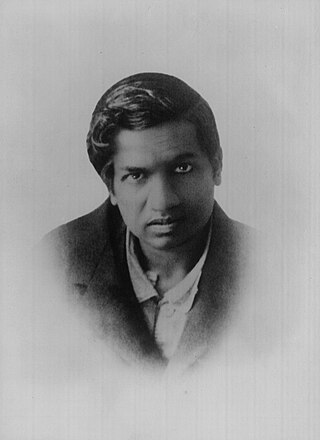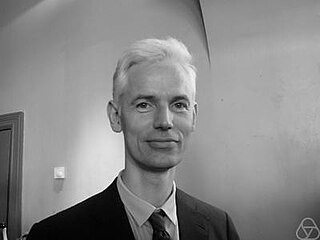Related Research Articles

Stephen Smale is an American mathematician, known for his research in topology, dynamical systems and mathematical economics. He was awarded the Fields Medal in 1966 and spent more than three decades on the mathematics faculty of the University of California, Berkeley, where he currently is Professor Emeritus, with research interests in algorithms, numerical analysis and global analysis.

In the area of abstract algebra known as group theory, the monster group M (also known as the Fischer–Griess monster, or the friendly giant) is the largest sporadic simple group, having order
808,017,424,794,512,875,886,459,904,961,710,757,005,754,368,000,000,000
= 246 · 320 · 59 · 76 · 112 · 133 · 17 · 19 · 23 · 29 · 31 · 41 · 47 · 59 · 71
≈ 8×1053.

Srinivasa Ramanujan (22 December 1887 – 26 April 1920) was an Indian mathematician. Though he had almost no formal training in pure mathematics, he made substantial contributions to mathematical analysis, number theory, infinite series, and continued fractions, including solutions to mathematical problems then considered unsolvable.

The American Mathematical Society (AMS) is an association of professional mathematicians dedicated to the interests of mathematical research and scholarship, and serves the national and international community through its publications, meetings, advocacy and other programs.

Sir William Timothy Gowers, is a British mathematician. He is Professeur titulaire of the Combinatorics chair at the Collège de France, and director of research at the University of Cambridge and Fellow of Trinity College, Cambridge. In 1998, he received the Fields Medal for research connecting the fields of functional analysis and combinatorics.

Neil James Alexander Sloane FLSW is a British-American mathematician. His major contributions are in the fields of combinatorics, error-correcting codes, and sphere packing. Sloane is best known for being the creator and maintainer of the On-Line Encyclopedia of Integer Sequences (OEIS).

Harold Calvin Marston Morse was an American mathematician best known for his work on the calculus of variations in the large, a subject where he introduced the technique of differential topology now known as Morse theory. The Morse–Palais lemma, one of the key results in Morse theory, is named after him, as is the Thue–Morse sequence, an infinite binary sequence with many applications.
The Adams Prize is a prize awarded each year by the Faculty of Mathematics at St John's College to a UK-based mathematician for distinguished research in mathematical sciences.
Jonathan Michael Borwein was a Scottish mathematician who held an appointment as Laureate Professor of mathematics at the University of Newcastle, Australia. He was a close associate of David H. Bailey, and they have been prominent public advocates of experimental mathematics.

Doron Zeilberger is an Israeli mathematician, known for his work in combinatorics.

The Mathematical Association is a professional society concerned with mathematics education in the UK.

Richard Allen Askey was an American mathematician, known for his expertise in the area of special functions. The Askey–Wilson polynomials are on the top level of the Askey scheme, which organizes orthogonal polynomials of hypergeometric type into a hierarchy. The Askey–Gasper inequality for Jacobi polynomials is essential in de Brange's famous proof of the Bieberbach conjecture.
Joseph Bishop Keller was an American mathematician who specialized in applied mathematics. He was best known for his work on the "geometrical theory of diffraction" (GTD).

The Mathematical Institute is the mathematics department at the University of Oxford in England. It is one of the nine departments of the university's Mathematical, Physical and Life Sciences Division. The institute includes both pure and applied mathematics and is one of the largest mathematics departments in the United Kingdom with about 200 academic staff. It was ranked as the top mathematics department in the UK in the 2021 Research Excellence Framework. Research at the Mathematical Institute covers all branches of mathematical sciences ranging from, for example, algebra, number theory, and geometry to the application of mathematics to a wide range of fields including industry, finance, networks, and the brain. It has more than 850 undergraduates and 550 doctoral or masters students. The institute inhabits a purpose-built building between Somerville College and Green Templeton College on Woodstock Road, next to the Faculty of Philosophy.
Plus Magazine is an online popular mathematics magazine run under the Millennium Mathematics Project at the University of Cambridge.
Samuel Karlin was an American mathematician at Stanford University in the late 20th century.

Hamid Naderi Yeganeh is an Iranian mathematical artist and digital artist. He is known for using mathematical formulas to create drawings of real-life objects, intricate and symmetrical illustrations, animations, fractals and tessellations. Naderi Yeganeh uses mathematics as the main tool to create artworks. Therefore, his artworks can be totally described by mathematical concepts. Mathematical concepts he uses in his work include trigonometric functions, exponential function, Fibonacci sequence, sawtooth wave, etc.
Stephen Albert Fulling is an American mathematician and mathematical physicist, specializing in the mathematics of quantum theory, general relativity, and the spectral and asymptotic theory of differential operators. He is known for preliminary work that led to the discovery of the hypothetical Unruh effect.
Walter Wilson Stothers was a British mathematician who proved the Stothers-Mason Theorem in the early 1980s.
References
- ↑ "Math Dept Home Page of W. Stephen Wilson". Math.jhu.edu. Retrieved 7 June 2016.
- ↑ W. Stephen Wilson at the Mathematics Genealogy Project
- ↑ "American Mathematical Society". Ams.org. Retrieved 7 June 2016.